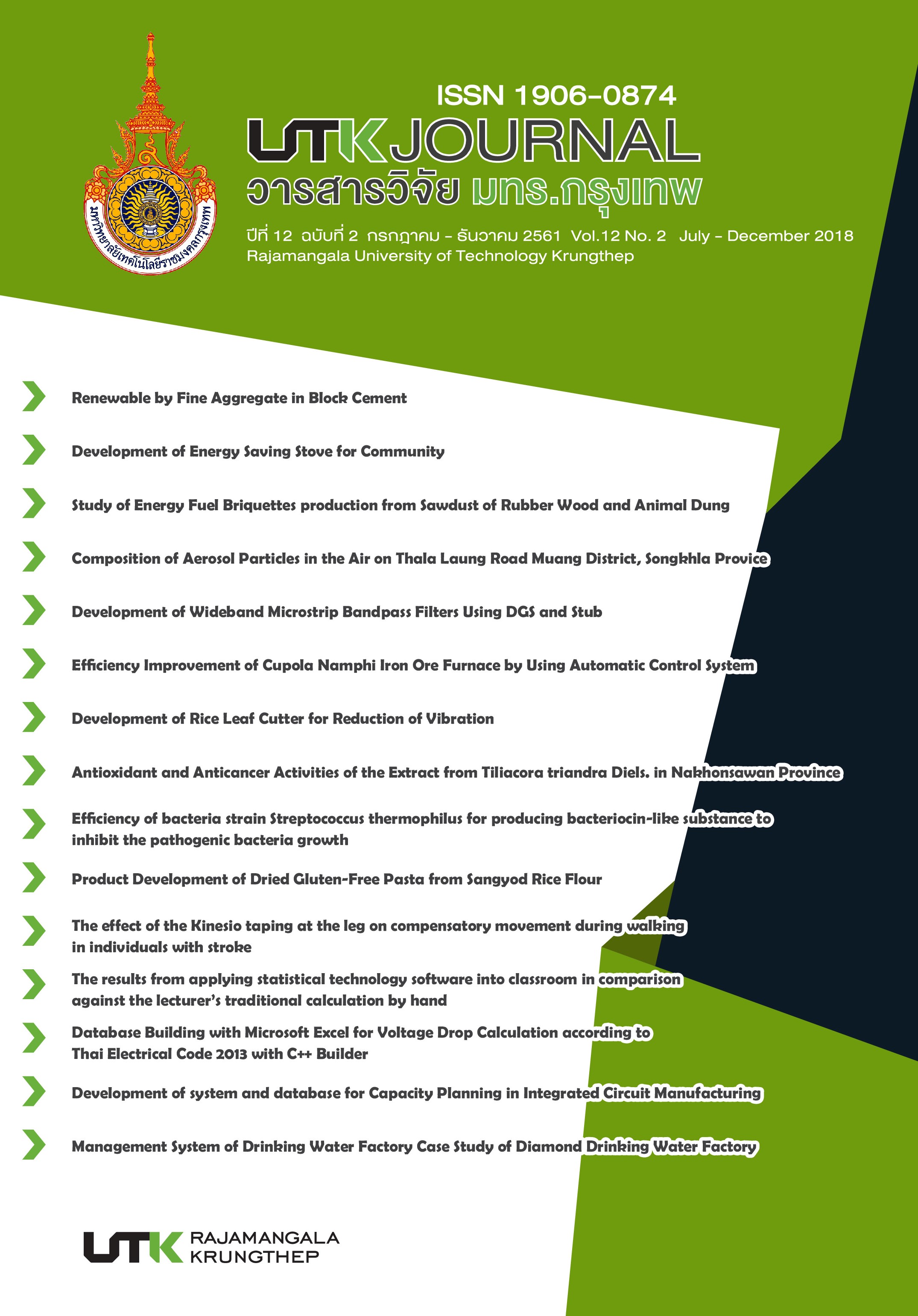The results from applying statistical technology software into classroom in comparison against the lecturer’s traditional calculation by hand
คำสำคัญ:
Applying statistical technology software, Traditional calculation by hand, Benefit of using technologyบทคัดย่อ
The purpose of this research was to find out whether or not technology which has impact on the student's motivation, interested way of learning, understanding, ability to apply after graduation, effectiveness and should be applied again in the statistic subject. Our procedure involved the completion of one real classroom over the course of 15 weeks study. The entire class was designed to learn by the traditional way along with the computer-based statistical software to calculate the complicated numbers in statistics subject in order to compare the differences. Likert scale questionnaire and before-after-statistical test were used as tools to collect and analyze the data respectively. In addition, in-depth interview was also included to ensure the quality of quantitative findings. Results of this research indicated the idea that when applying technology into classroom at university level, students evidently and strongly prefer the technology rather than the traditional method where calculations take long time and are done by hand on the board.
เอกสารอ้างอิง
[2] O’Donoghue J., Singh G., Green C. A Comparison of the Advantages and Disadvantages of IT Based Education and the Implications upon Students. Interactive Educational Multimedia. 2004; 9:63-76.
[3] Ball DL., Forzani FM. The Work of Teaching and the Challenge for Teacher Education. Journal of Teacher Education. 2009; 60(5):497-511.
[4] Saba A. Benefits of Technology Integration in Education. Synthesis paper, Boise: EducationTech 501; 2009.
[5] Tas S. According to Candidate Teachers Views Classroom Management Problems of Teachers in Traditional and Technology-supported Classrooms. Universal Journal of Educational Research 2017; 5(11):2005-15.
[6] Koedinger K., Anderson JR., Hadley W.H., Mark M.A. Intelligent tutoring goes to school in the big city. International Journal of Artificial Intelligence in Education. 1997; 1(8):30-43.
[7] Angrist J., Lavy V. New evidence on classroom computers and Pupil learning. The Economic Journal. 2002; 112:735-65.
[8] McIntyre D., Pedder D. and Rudduck J. Pupil voice: comfortable and uncomfortable learnings for teachers. Research Papers in Education. 2005; 20(2):149-68.
[9] Morgan P., Ritter S. An experimental study of the effects of Cognitive Tutor® Algebra 1 on student knowledge and attitude. Pittsburgh: Carnegie Learning, Inc.; 2002.
[10] Harandi SR. Effects of e-learning on students’motivation. Procedia-Social and Behavioral Sciences. 2015; 181: 423-30.
[11] Temple E., Deutsch G., Poldrack R., et al. Neural deficits in children with dyslexia ameliorated by behavioral remediation: Evidence from functional MRI. Proceedings from the National Academy of Sciences. 2003; 100(5):2860-5.
[12] Yusuf MO. Information and communication education: Analyzing the Nigerian national policy for information technology”, International Education Journal. 2005; 6(3):316-21.
[13] Funkhouser C. The Effect of Computer-Augmented Geometry Instruction on Student Performance and Attitudes. Journal of Research on Technology in Education. 2002; 35(2):163-75.
[14] Norton S., McRobbie C.J. and Cooper T.J. Exploring Secondary Mathematics Teachers’ Reasons for not using Computers in Their Teaching: Five Cases Studies. Journal of Research on Computing Education. 2000; 33(1): 87-110.
[15] Nworie J., Haughton N. Good intentions and unanticipated effects: The unintended consequences of application of technology in teaching and learning environments. Tech Trends. 2008; 5(5):52-8.
[16] Riasati MJ., Allahyar N., Tan K. Technology in Language Education: Benefits and Barriers. Journal of Education and Practice. 2012; 3(5): 25-30.
[17] Younes MB., Al-Zoubi S. The Impact of Technologies on Society: A Review. IOSR Journal of Humanities and Social Science. 2015; 20(2): 82-6.
[18] Davies TL., Lavin A.M., Korte L. Student perceptions of how technology impacts the quality of instruction and learning. Journal of Instructional Pedagogies. 2009; 1: 2-16.
ดาวน์โหลด
เผยแพร่แล้ว
รูปแบบการอ้างอิง
ฉบับ
ประเภทบทความ
สัญญาอนุญาต
กองบรรณาธิการวารสารวิชาการ มหาวิทยาลัยเทคโนโลยีราชมงคลกรุงเทพ มีความยินดีที่จะรับบทความจากอาจารย์ นักวิจัย นักวิชาการทั้งภายในและภายนอกมหาวิทยาลัย ในสาขาวิชาวิทยาศาสตร์และเทคโนโลยี ได้แก่ สาขาวิชาวิทยาศาสตร์ วิศวกรรมศาสตร์ และสาขาอื่นๆ ที่เกี่ยวข้อง รวมถึงสาขาต่างๆ ที่มีการบูรณาการข้ามศาสตร์ที่เกี่ยวข้องวิทยาศาสตร์และเทคโนโลยี ที่เขียนเป็นภาษาไทยหรือภาษาอังกฤษ ซึ่งผลงานวิชาการที่ส่งมาขอตีพิมพ์ต้องไม่เคยเผยแพร่ในสิ่งพิมพ์อื่นใดมาก่อน และต้องไม่อยู่ในระหว่างการพิจารณาของวารสารอื่น
การละเมิดลิขสิทธิ์ถือเป็นความรับผิดชอบของผู้ส่งบทความโดยตรง บทความที่ได้รับการตีพิมพ์ต้องผ่านการพิจารณากลั่นกรองคุณภาพจากผู้ทรงคุณวุฒิและได้รับความเห็นชอบจากกองบรรณาธิการ
ข้อความที่ปรากฏอยู่ในแต่ละบทความที่ตีพิมพ์ในวารสารวิชาการเล่มนี้ เป็นความคิดเห็นส่วนตัวของผู้เขียนแต่ละท่าน ไม่เกี่ยวข้องกับมหาวิทยาลัยเทคโนโลยีราชมงคลกรุงเทพแต่อย่างใด ความรับผิดชอบด้านเนื้อหาและการตรวจร่างบทความแต่ละบทความเป็นของผู้เขียนแต่ละท่าน หากมีความผิดพลาดใดๆ ผู้เขียนแต่ละท่านจะต้องรับผิดชอบบทความของตนเองแต่ผู้เดียว
กองบรรณาธิการขอสงวนสิทธิ์มิให้นำเนื้อหา หรือข้อคิดเห็นใดๆ ของบทความในวารสารวิชาการ มหาวิทยาลัยเทคโนโลยีราชมงคลกรุงเทพ ไปเผยแพร่ก่อนได้รับอนุญาตจากกองบรรณาธิการ อย่างเป็นลายลักษณ์อักษร ผลงานที่ได้รับการตีพิมพ์ถือเป็นลิขสิทธิ์ของวารสาร






